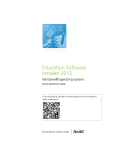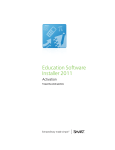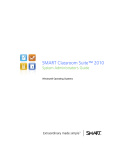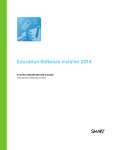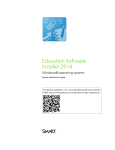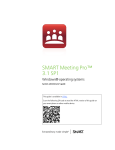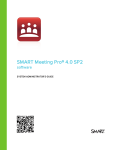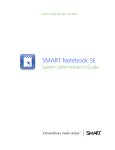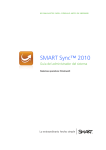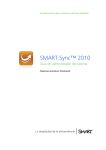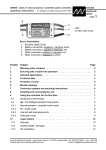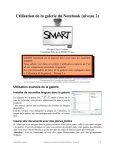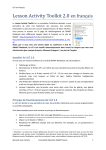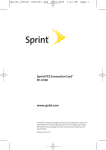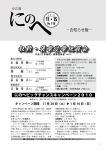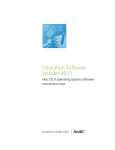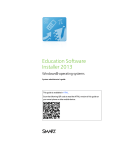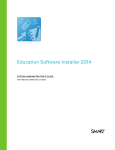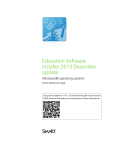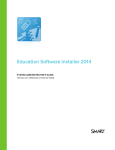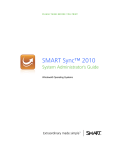Download Education Software Installer 2011 system administrator`s guide for
Transcript
Education Software Installer 2011 Windows® operating systems System administrator’s guide Trademark notice SMART Notebook, SMART Document Camera, SMART Response, SMART Sync, SMART Classroom Suite, Senteo, SMART Board, smarttech, the SMART logo and all SMART taglines are trademarks or registered trademarks of SMART Technologies ULC in the U.S. and/or other countries. Windows, Windows Vista, Internet Explorer, ActiveX and DirectX are either registered trademarks or trademarks of Microsoft Corporation in the U.S. and/or other countries. Adobe and Flash are either registered trademarks or trademarks of Adobe Systems Incorporated in the U.S. and/or other countries. All other third-party product and company names may be trademarks of their respective owners. Copyright notice © 2011 SMART Technologies ULC. All rights reserved. No part of this publication may be reproduced, transmitted, transcribed, stored in a retrieval system or translated into any language in any form by any means without the prior written consent of SMART Technologies ULC. Information in this manual is subject to change without notice and does not represent a commitment on the part of SMART. One or more of the following patents: US6320597; US6326954; US6741267; US7151533; US7757001; USD612396; USD616462; USD617332; and USD636784. Other patents pending. 10/2011 Installation overview Task Reference Ensure your computers meet the minimum requirements. page 2 Obtain the installation packages and supporting files. page 3 If previous versions of the software are installed on your computer, remove them. page 73 Customize the installation packages using SMART Install Manager. page 5 OR OR Customize the installation packages using a third-party tool. page 16 Deploy the installation packages. page 17 If the software didn’t activate during installation, activate it. page 20 Please send any feedback on this guide to [email protected]. i Contents Installation overview i Chapter 1: Getting started 1 Computer requirements Installation packages and supporting files 2 3 Chapter 2: Customizing installation packages 5 Using SMART Install Manager Using third-party tools Chapter 3: Deploying the software Using the command line interface Using third-party imaging or remote management software Activating the software after installation Chapter 4: Updating the software Using a Windows Installer update installation package (MSI file) Using a Windows Installer patch (MSP file) Chapter 5: Removing the software Using the command line interface Using third-party imaging or remote management software Appendix A: Windows Installer properties and parameters Properties Parameters Examples Appendix B: Language files and codes Installation language files and codes Language packs Appendix C: Installing and maintaining Gallery content Installing Gallery content Modifying Gallery content Changing Gallery content locations 5 16 17 17 19 20 27 28 29 31 31 36 37 37 50 50 53 53 54 57 58 63 69 Appendix D: Removing previous versions 73 Removing SMART Board software 9.x Removing SMART Board software 8.x 73 74 iii C ON T EN T S Removing SMART Board software 7.x Cleaning the registry Index iv 76 77 79 Chapter 1 Getting started Computer requirements Installation packages and supporting files Installation packages Language files This guide explains how to customize and deploy the following software: l SMART Notebook™ collaborative learning software 10.8 l SMART Notebook Math Tools l Mixed Reality Tools for SMART Document Camera™ l SMART Product Drivers 10.8 l SMART Response™ 2011 assessment software l SMART Sync™ 2011 Teacher software l SMART Classroom Suite™ 2011 Teacher software l Common platform N N OTES l For information on customizing and deploying previous versions of this software, see the appropriate system administrator’s guides at smarttech.com/support. l For information on installing SMART Sync Student software, SMART Sync Class List Server and SMART Administrator Tools - Classlist Manager, see the SMART Sync 2011 system administrator’s guide (smarttech.com/kb/160490) or the SMART Classroom Suite 2011 system administrator’s guide (smarttech.com/kb/160522). 1 2 3 3 4 CHAPT ER 1 Getting started This guide is intended for IT administrators and others experienced with customizing, deploying and administering Windows® software in a networked environment. To use this guide, you must: l Know IT terminology such as “registry” and “domain controller” l Know how to complete basic administrative tasks in Windows operating systems such as modifying the registry l Have administrative privileges and access to servers l Have access to the DVD or have Internet access I I MPOR TA N T You must run the commands documented in this guide in an Administrator Command Prompt window. To open an Administrator Command Prompt window, right-click the Command Prompt icon, and then select Run as Administrator. Computer requirements Before you install the software, ensure your teachers’ computers meet the minimum requirements: l Pentium® 4 processor or better l 512 MB of RAM (1 GB recommended) l Free hard disk space: Software Space required SMART Notebook software Gallery Essentials 549 MB Lesson Activity Toolkit 111 MB SMART Product Drivers 145 MB SMART Response assessment software 47 MB SMART Sync Teacher software 37 MB Common platform 62 MB Total 2 277 MB l Windows XP SP3, Windows Vista® SP2 or Windows 7 operating system l Adobe®Flash® Player 10 ActiveX® control for SMART Notebook software l Adobe Flash Player 10 Firefox® plug-in for SMART Response assessment software l DirectX® technology 8.1 or later for SMART Video Player l DirectX 9 compatible graphics hardware for Mixed Reality Tools 1228 MB CHAPT ER 1 Getting started N N OTE If you’re deploying SMART software to Windows XP or Windows Vista computers, you must first install Windows Installer 4.5 on these computers. You can download Windows Installer 4.5 from support.microsoft.com/kb/942288. Installation packages and supporting files Before you can customize or deploy SMART software, you must locate the installation packages and supporting files. Installation packages There are three installation packages (also known as an MSI files) for the Education Software Installer: Installation package File name Education Software Installer SMART Education Software 2011.msi AdobeFlash Player ActiveX control (for SMART Notebook software) install_flash_player_10_active_x.msi Adobe Flash Player plug-in (for SMART Response assessment software) install_flash_player_10_plugin.msi I I MPOR TA N T SMART recommends that you deploy SMART software using the SMART Education Software 2011.msi installation package. However, if you choose to deploy the software using individual installation packages, you need to do the following: l Deploy the SMART Common Platform.msi file first. l If you use a custom value for the INSTALLDIR property, ensure this value is identical across all the installation packages. The SMART Education Software 2011.msi file is located on the DVD in [DVD drive]:\Administrators\Windows\Education Software Install. The Adobe Flash Player files are located on the DVD in [DVD drive]:\Administrators\Windows\Education Software Install\Support Alternatively, you can download the packages from smarttech.com/administratordownloads. Save the packages in a location on your network that’s accessible to all computers on which you plan to install the software. 3 CHAPT ER 1 Getting started Language files If you plan to deploy the installation packages in a language other than English (U.S.), ensure the corresponding MST file for the language is in the same folder as the MSI file (see Installation language files and codes on page 53). Similarly, if you want users to be able to view and use the software in a language other than English, you must download and install the appropriate language pack (see Language packs on page 54). These language packs are located on the DVD under [DVD drive]:\Administrators\Windows\Education Software Install\Support\Languages. 4 Chapter 2 Customizing installation packages Using SMART Install Manager Installing SMART Install Manager Using SMART Install Manager Opening an installation package Saving your changes Publishing your changes as an MST file Customizing the installation package Using third-party tools You can customize installation packages using SMART Install Manager. OR You can customize installation packages using third-party tools and Windows Installer properties. Using SMART Install Manager SMART Install Manager enables you to customize SMART software installation packages (also known as MSI files) by publishing MST files. You can then deploy the MSI and MST files to computers using third-party imaging or remote management software. Installing SMART Install Manager Install SMART Install Manager from the DVD. OR Download and install SMART Install Manager from the SMART Support website. g To install SMART Install Manager from the DVD 1. Insert the DVD in your computer’s DVD drive. A dialog box appears. 5 5 5 6 6 7 7 8 16 CHAPT ER 2 Customizing installation packages N N OTE If the dialog box doesn’t appear, browse to and open [DVD drive]\CDBrowser.exe in Windows Explorer. 2. Click Administrator Preparation and Tools, and then click Install SMART Install Manager. The SMART Install Manager installation wizard appears. 3. Follow the on-screen instructions. g To install SMART Install Manager from the website 1. Go to smarttech.com/administratordownloads. 2. Scroll to SMART Notebook collaborative learning software, click Choose a version, and then select SMART Notebook software > 10.8 for Windows. 3. Click Download SMART Install Manager, and then click Download. 4. Save the Install Manager.exe file to your computer. 5. Double-click the Install Manager.exe file. The SMART Install Manager installation wizard appears. 6. Follow the on-screen instructions. Using SMART Install Manager After you install SMART Install Manager, shortcuts to the software appear on the desktop and in the Start menu under All Programs > SMART Technologies > SMART Install Manager. With SMART Install Manager, you can do the following: l Open and customize an installation package. l Save your changes to the installation package as an XML file. l Publish your changes to the installation packages as an MST file. Opening an installation package To customize an installation package, drag its MSI file into the SMART Install Manager window. Alternatively, you can search for installation packages on your computer by clicking DVDs by clicking 6 . , or on CDs or CHAPT ER 2 Customizing installation packages N N OTE All installation packages you’ve previously opened in SMART Install Manager appear in the Unmodified Packages tab. After you open an installation package, a set of pages for that installation package appears in SMART Install Manager. Customize the installation package using the controls on these pages. Saving your changes After you customize an installation package, save your changes as an XML file by selecting File > Save As. When you next start SMART Install Manager, load the XML file by selecting File > Open, or by opening the MSI file and then selecting File > Import. Publishing your changes as an MST file The final step in using SMART Install Manager to customize an installation package is to publish your changes as an MST file. To do this, select File > Publish, and then use the dialog box to define a location for and create the MST file. T TIP Publish the MST file in the same location as the MSI file. 7 CHAPT ER 2 Customizing installation packages Customizing the installation package To customize the installation package, open the SMART Education Software 2011.msi file in SMART Install Manager (see Using SMART Install Manager on page 6), and then set the controls on each page. Control Procedure Notes General Options: Product Selection Activate software during installation Select to activate the software automatically during installation rather than manually after installation. You must include the product key properties for the software you are installing for this property to work. For mass activation information, see Activating the software after installation on page 20. SMART Product Drivers Select to install SMART Product Drivers. SMART Notebook software Select to install SMART Notebook software. Product key Type your 22-character product key for SMART Notebook software. You can type the product key with or without hyphens. SMART Response software Select to install SMART Response software. If you choose to install SMART Response software, you must also install and activate SMART Notebook software. When you select this check box, SMART Install Manager automatically selects the SMART Notebook check box. Product key If you’re installing SMART Response software and students use SMART Notebook SE (Student Edition) software or SMART Response VE Internetenabled devices to answer questions, type your 22-character product key for SMART Response software. You can type the product key with or without hyphens. 8 When you type a volume product key, the software activates when you deploy it to your network computers. When you type a volume product key, the software activates when you deploy it to your network computers. CHAPT ER 2 Customizing installation packages Control Procedure SMART Notebook Math Select to install SMART Notebook If you choose to install Math Tools. SMART Notebook Math Tools, you must also install and activate SMART Notebook software. Tools Notes If you install SMART Notebook software but don’t install SMART Notebook Math Tools or Mixed Reality Tools, you’re unable to deploy this software at a later date using the Education Software Installer installation package. Product key Type your 22-character product key for SMART Notebook Math Tools. SMART Document Camera Select to install Mixed Reality Mixed Reality Tools Tools. You can type the product key with or without hyphens. When you type a volume product key, the software activates when you deploy it to your network computers. If you choose to install Mixed Reality Tools, you must also install and activate SMART Notebook software. If you install SMART Notebook software but don’t install SMART Notebook Math Tools or Mixed Reality Tools, you’re unable to deploy this software at a later date using the Education Software Installer installation package. Product key Type your 22-character product key for Mixed Reality Tools. You can type the product key with or without hyphens. When you type a volume product key, the software activates when you deploy it to your network computers. SMART Sync Teacher software 9 Select to install SMART Sync Teacher software. CHAPT ER 2 Customizing installation packages Control Procedure Notes Product key Type your 22-character product key for SMART Sync Teacher software. You can type the product key with or without hyphens. SMART Classroom Suite software Select to install SMART Classroom Suite Teacher software. When you select this check box, SMART Install Manager automatically selects the SMART Notebook, SMART Product Drivers, SMART Response and SMART Sync Teacher check boxes. (These programs are part of SMART Classroom Suite Teacher software.) Product key Type your 22-character product key for SMART Classroom Suite Teacher software. You can type the product key with or without hyphens. When you type a volume product key, the software activates when you deploy it to your network computers. When you type a volume product key, the software activates when you deploy it to your network computers. General Options: Installation Options Installation directory Type the path to your preferred folder for the software. If you specify a folder, include a back slash (\) at the end of the path. If you don’t specify a folder, Windows Installer installs the software in [Program files]\ SMART Technologies\ Education Software where [Program files] is C:\Program Files for 32-bit versions of Windows operating systems or C:\Program File (x86) for 64-bit versions of Windows operating systems. Ensure the folder path is valid. SMART Install Manager doesn’t verify the folder path. Install Start menu and desktop shortcuts 10 Select to create shortcuts in the Start menu and on the desktop. CHAPT ER 2 Customizing installation packages Control Procedure Notes General Options: Language Selection Select the language packs you want to install Select the check boxes of the language packs you want to install. Some SMART software doesn’t support all listed languages. SMART Sync Teacher software language support is managed separately. General Options: SMART Product Update Options Install SMART Product Update in Full Mode Select to install SMART Product Update (SPU) in Full mode. In Full mode, users can view currently installed versions of SMART software and their product keys, and download and install updates. Install SMART Product Select to install SPU in Dashboard In Dashboard mode, users can Update in Dashboard Mode mode. view only currently installed versions of SMART software and their product keys. Do not install SMART Product Update Select to not install SPU. Check for updates Type the number of days (1 to 60) between SPU checks. This option is available only if you install SPU in Full mode. By default, SPU checks for product updates every 30 days. Notify users about SMART Select to notify users of available product updates SMART product updates through the Windows notification area. This option is available only if you install SPU in Full mode. SMART Notebook: Gallery Content See Installing and maintaining Gallery content on page 57. SMART Notebook: Team Content Team Content path Type the path to the Team Content folder, which is a location on your school’s network where users can store shared content. For information on creating a Team Content folder, see Creating or connecting to Team Content folders on page 70. SMART Notebook: My Content My Content path 11 Type the path to the My Content folder, which is a location on the user’s computer where he or she can store individual content. You can include environment variables in the path. CHAPT ER 2 Customizing installation packages Control Procedure Notes SMART Notebook: Optional Settings Install print capture driver Select to include the Print Capture The Print Capture Driver is a Driver in the installation. printer driver that enables users to export content from other programs to SMART Notebook software by using the SMART Notebook Document Writer. Register Select to enable the registration of Disable the registration of SMART Document Camera SMART Document Camera SMART Document Camera drivers drivers. drivers if they conflict with existing third-party drivers on the computer. If you choose to install Mixed Reality Tools, SMART Install Manager selects this check box automatically. You’re unable to clear it. Install Notebook Plugin IE Helper Object Select to enable a plug-in that allows you to download .notebook files from Internet Explorer® Internet browser. If you don’t enable the plug-in, Internet Explorer Internet browser changes .notebook files’ extensions to .zip when downloading them. As a result, users are unable to open the files in SMART Notebook software. If you have a security policy restricting the installation of any Internet Explorer ActiveX plug-ins (32-bit operating systems), don’t enable the plug-in or the installation might not succeed. SMART Notebook: Customer Experience Prompt users to choose to participate in the Customer Experience Program Select to allow the user to enable or disable the Customer Experience Program. Enable the Customer Experience Program on all computers Select to automatically enable the Customer Experience Program for the user. Disable the Customer Experience Program on all computers Select to automatically disable the Customer Experience Program for the user. 12 When the software first starts, it will ask the user whether he or she wants to participate in the Customer Experience Program. CHAPT ER 2 Customizing installation packages Control Procedure Notes SMART Response: Activation Options Registry file If you’re installing SMART Response software in standard, LE, PE, XE or mixed modes, type the path to the activation registry file. SMART Response: Setup Tool SMART Response LE Select to enable students to answer questions with SMART Response LE clickers. SMART Response PE Select to enable students to answer questions with SMART Response PE clickers. SMART Response XE Select to enable students to answer questions with SMART Response XE clickers. SMART Response/Senteo Select to enable students to answer questions with SMART Response or Senteo™ clickers. SMART Response VE Select to enable students to answer questions with SMART Response VE Internetenabled devices. 13 Contact SMART Support for details. CHAPT ER 2 Customizing installation packages Control Procedure SMART Notebook SE Select to enable students to answer questions with SMART Notebook SE software in SMART Response CE mode. Notes Multiple SMART Response Select to enable students to devices in the same class answer questions with Senteo, SMART Response, SMART Response LE, SMART Response PE or SMART Response XE clickers or SMART Notebook SE software. Select the Include SMART Response VE check box to also enable students to answer questions with SMART Response VE Internet-enabled devices. SMART Response: Optional Settings Start Desktop Menu at log in for all users? Select to start SMART Response software when the user logs on. File port Type the port number for the file data channel. OR Secure Base port Type * to use a random port number for the file data channel. The default port is 23458. Type the port number for the encrypted data channel. This control is applicable only if students answer questions with SMART Notebook SE software. OR Certificate file Type * to use a random port number for the encrypted data channel. The default port is 23457. Type the path to the certificate file for SSL digital certificate encryption. This control is applicable only if students answer questions with SMART Notebook SE software. OR Click Browse and then browse to and select the certificate file. 14 This control is applicable only if students answer questions with SMART Notebook SE software. CHAPT ER 2 Customizing installation packages Control Procedure Notes SMART Sync Teacher: Administrator Setup Administer class lists using Select to administer class lists a SMART School file using a SMART School file, and then type the path to the SMART School file in the File location box or click Browse, and then browse to and select the SMART School file. Connect students using SMART Sync Classlist Server Before you can specify the path to a SMART School file, you must install SMART Administrator Tools - Classlist Manager, and then use it to create the SMART School file. Select to connect students using SMART Sync Class List Server, and then type the host name or IP address for SMART Sync Class List Server in the Hostname or IP address box. SMART Product Drivers: Optional Settings Enable Tablet PC Support Select to use Tablet PC functionality with the SMART Board™ interactive whiteboard without having to connect a Tablet PC. Start SMART Board Tools at logon Select to start SMART Board Tools when the user logs on. Start Simple Network Management Protocol (SNMP) Agent Select to enable remote monitoring and control of your SMART products and projectors from a central location using SMART SNMP Agent. Register unsigned drivers Select to enable the registration of If you enable the registration of unsigned third-party drivers. unsigned third-party drivers, the installation process could ask users if they trust the makers of the drivers during installation. This can cause issues if you deploy the installation in Silent mode. Therefore, it’s best to disable the registration of third-party drivers if you deploy the installation in Silent mode. 15 This property is applicable for the Windows Vista and Windows 7 operating systems. It has no effect on other operating systems. CHAPT ER 2 Customizing installation packages Using third-party tools You can customize SMART software installation packages by creating MST files using a third-party tool, such as Orca database editor, and the Windows Installer properties (see Windows Installer properties and parameters on page 37). 16 Chapter 3 Deploying the software Using the command line interface Using third-party imaging or remote management software Activating the software after installation 17 19 20 You can deploy installation packages using the command line interface. OR You can deploy installation packages using third-party imaging or remote management software. I I MPOR TA N T l Regardless of how you deploy the software, you must choose to install at least one of the software products. Otherwise, the SMART Education Software 2011.msi file doesn’t install any of the software products. l If you’re deploying SMART Product Drivers, the user must restart (Windows XP operating systems) or log off and log back on (Windows Vista and Windows 7 operating systems) after you deploy the software to start the SMART Board Service. In addition, an error message might appear after you deploy the software stating that the SMARTBoardService.exe file could not be found. The user can close this error message. l If you want to install language packs, you must do so when you first deploy the software. If you want to install a language pack after you first deploy the software, you must do so using the language pack’s individual MSI file. N N OTE You might need to manually activate the software after you deploy it. Using the command line interface Using the command line interface, you can deploy installation packages in many ways, including running commands from the Command Prompt window and including commands in batch script files. 17 CHAPT ER 3 Deploying the software g To install SMART software Run the following command if you created an MST file to customize the installation package: msiexec /i "[Path]\SMART Education Software 2011.msi" TRANSFORMS="[MST file]" [Parameter] OR Run the following command if you didn’t create an MST file to customize the installation package: msiexec /i "[Path]\SMART Education Software 2011.msi" [Properties] [Parameter] Where l [Path] is the path to the SMART Education Software 2011.msi file and MST file. l [MST file] is the name of the MST file. l [Properties] is a set of properties you can include to customize the installation (see Properties on page 37). l [Parameter] is the installation parameter (see Parameters on page 50). g To install the Adobe Flash Player ActiveX control Run the following command: msiexec /i "[Path]\install_flash_player_10_active_x.msi" [Parameter] Where l [Path] is the path to the install_flash_player_10_active_x.msi file. l [Parameter] is the installation parameter (see Parameters on page 50). g To install the Adobe Flash Player plug-in Run the following command: msiexec /i "[Path]\install_flash_player_10_plugin.msi" [Parameter] Where 18 l [Path] is the path to the install_flash_player_10_plugin.msi file. l [Parameter] is the installation parameter (see Parameters on page 50). CHAPT ER 3 Deploying the software Using third-party imaging or remote management software The following procedure shows how to deploy SMART software using Group Policy-based deployment software. For information on deploying SMART software using your organization’s third-party imaging or remote management software, see the software’s documentation. N N OTES l This procedure may vary depending on your version of Windows operating system and your system preferences. l Ensure your domain controller has Windows Installer 4.5. g To deploy an installation package 1. Copy the MSI file and the MST file to \\[Domain Controller]\NETLOGON , where [Domain Controller] is your domain controller. 2. Open Control Panel, double-click Administrative Tools, and then double-click Active Directory Users and Computers. The Active Directory Users and Computers window appears. 3. Right-click your domain, and then select Properties. The Properties dialog box appears. 4. Click the Group Policy tab, and then click Edit. The Group Policy Object Editor dialog box appears. 5. Browse to and open Computer Configuration\Software Settings. 6. Right-click Software Installation, select New > Package, and then browse to and select the MSI file from step 1. 7. In the Deploy Software section, click Advanced, and then click OK. 8. Click the Modifications tab, click Add, and then browse to and select the MST file from step 1. 9. Click OK to apply the MST file to the MSI file. 19 CHAPT ER 3 Deploying the software 10. Close all open windows and dialog boxes. The next time each computer on the domain starts, the computer automatically installs the software in Silent mode with the customizations defined in the MST file. Activating the software after installation There are two situations in which the software doesn’t activate completely: l Imaging a computer: For the software to activate properly, each computer you install it on must have a unique installation ID. If you use a computer image or clone a hard drive to set up multiple computers, they all have the same installation ID as the original computer, which can cause an activation error. l Protecting software for computer configurations: If you use system recovery or protection software, you should activate the software before you lock or freeze the computer for your users. However, if you can’t, you must activate the software afterward. Run the activation wizard while connected to the network or complete the following procedure to activate the software on each computer. g To activate SMART software after installation Run the following command: "C:\Program Files\Common Files\SMART Technologies\ SMART Product Update\activationwizard.exe" --puid education_bundle --m=[Value] --v=1 --a [Optional flags] [Product keys] Where l [Value] is 4 to run the activation wizard in unattended mode. OR [Value] is 6 to run the activation wizard in user interface mode. 20 CHAPT ER 3 Deploying the software l l [Optional flags] are optional flags you can include to configure the activation wizard. Flag Purpose --monitor=[Number] Specify the monitor to display the activation wizard. --proxy=[Host:Port] Specify the proxy host and port number to use for activation. --proxyuser=[User] Specify the proxy user name to use for activation. --proxypassword=[Password] Specify the proxy password to use for activation. --locale=[Code] Display the activation wizard user interface in a specific language, where [Code] is your language code. [Product keys] are one or more software product keys you want to activate. Each product key must be in the following form: --pk [Product key] Where [Product key] is the software product key. g To activate only SMART Classroom Suite Teacher software after installation Run the following command: "C:\Program Files\Common Files\SMART Technologies\ SMART Product Update\activationwizard.exe" --puid education_bundle --m=[Value] --v=1 --a [Optional flags] --pk [Product key] 21 CHAPT ER 3 Deploying the software Where l [Value] is 4 to run the activation wizard in unattended mode. OR [Value] is 6 to run the activation wizard in user interface mode. l l [Optional flags] are optional flags you can include to configure the activation wizard. Flag Purpose --monitor=[Number] Specify the monitor to display the activation wizard. --proxy=[Host:Port] Specify the proxy host and port number to use for activation. --proxyuser=[User] Specify the proxy user name to use for activation. --proxypassword=[Password] Specify the proxy password to use for activation. --locale=[Code] Display the activation wizard user interface in a specific language, where [Code] is your language code. [Product key] is the software product key. g To activate only SMART Notebook software after installation Run the following command: "C:\Program Files\Common Files\SMART Technologies\ SMART Product Update\activationwizard.exe" --puid notebook_10a --uipack notebook_10 --m=[Value] --v=1 --a [Optional flags] --pk [Product key] Where l [Value] is 4 to run the activation wizard in unattended mode. OR [Value] is 6 to run the activation wizard in user interface mode. 22 CHAPT ER 3 Deploying the software l l [Optional flags] are optional flags you can include to configure the activation wizard. Flag Purpose --monitor=[Number] Specify the monitor to display the activation wizard. --proxy=[Host:Port] Specify the proxy host and port number to use for activation. --proxyuser=[User] Specify the proxy user name to use for activation. --proxypassword=[Password] Specify the proxy password to use for activation. --locale=[Code] Display the activation wizard user interface in a specific language, where [Code] is your language code. [Product key] is the software product key. g To activate only SMART Notebook Math Tools after installation Run the following command: "C:\Program Files\Common Files\SMART Technologies\ SMART Product Update\activationwizard.exe" --puid education_bundle --m=[Value] --v=1 --a [Optional flags] --pk [Product key] Where l [Value] is 4 to run the activation wizard in unattended mode. OR [Value] is 6 to run the activation wizard in user interface mode. l l 23 [Optional flags] are optional flags you can include to configure the activation wizard. Flag Purpose --monitor=[Number] Specify the monitor to display the activation wizard. --proxy=[Host:Port] Specify the proxy host and port number to use for activation. --proxyuser=[User] Specify the proxy user name to use for activation. --proxypassword=[Password] Specify the proxy password to use for activation. --locale=[Code] Display the activation wizard user interface in a specific language, where [Code] is your language code. [Product key] is the software product key. CHAPT ER 3 Deploying the software g To activate only Mixed Reality Tools after installation Run the following command: "C:\Program Files\Common Files\SMART Technologies\ SMART Product Update\activationwizard.exe" --puid education_bundle --m=[Value] --v=1 --a [Optional flags] --pk [Product key] Where l [Value] is 4 to run the activation wizard in unattended mode. OR [Value] is 6 to run the activation wizard in user interface mode. l l [Optional flags] are optional flags you can include to configure the activation wizard. Flag Purpose --monitor=[Number] Specify the monitor to display the activation wizard. --proxy=[Host:Port] Specify the proxy host and port number to use for activation. --proxyuser=[User] Specify the proxy user name to use for activation. --proxypassword=[Password] Specify the proxy password to use for activation. --locale=[Code] Display the activation wizard user interface in a specific language, where [Code] is your language code. [Product key] is the software product key. g To activate only SMART Response software after installation Run the following command: "C:\Program Files\Common Files\SMART Technologies\ SMART Product Update\activationwizard.exe" --puid response_3a --uipack response_3 --m=[Value] --v=1 --a [Optional flags] --pk [Product key] Where l [Value] is 4 to run the activation wizard in unattended mode. OR [Value] is 6 to run the activation wizard in user interface mode. 24 CHAPT ER 3 Deploying the software l l N [Optional flags] are optional flags you can include to configure the activation wizard. Flag Purpose --monitor=[Number] Specify the monitor to display the activation wizard. --proxy=[Host:Port] Specify the proxy host and port number to use for activation. --proxyuser=[User] Specify the proxy user name to use for activation. --proxypassword=[Password] Specify the proxy password to use for activation. --locale=[Code] Display the activation wizard user interface in a specific language, where [Code] is your language code. [Product key] is the software product key. N OTE This command is applicable only if you’re running SMART Response software in CE mode (students answer questions with SMART Notebook SE software) or VE mode (students answer questions with Internet-enable devices). Instructions for activating all other modes are included in the SMART Response documentation. 25 CHAPT ER 3 Deploying the software g To activate only SMART Sync Teacher software after installation Run the following command: "C:\Program Files\Common Files\SMART Technologies\ SMART Product Update\activationwizard.exe" --puid sync_10 --uipack sync_10 --m=[Value] --v=1 --a [Optional flags] --pk [Product key] Where l [Value] is 4 to run the activation wizard in unattended mode. OR [Value] is 6 to run the activation wizard in user interface mode. l l 26 [Optional flags] are optional flags you can include to configure the activation wizard. Flag Purpose --monitor=[Number] Specify the monitor to display the activation wizard. --proxy=[Host:Port] Specify the proxy host and port number to use for activation. --proxyuser=[User] Specify the proxy user name to use for activation. --proxypassword=[Password] Specify the proxy password to use for activation. --locale=[Code] Display the activation wizard user interface in a specific language, where [Code] is your language code. [Product key] is the software product key. Chapter 4 Updating the software Using a Windows Installer update installation package (MSI file) Using a Windows Installer patch (MSP file) 28 29 SMART periodically releases updates to its software. These updates add new features and resolve issues. Go to smarttech.com/software to download the latest installation package. SMART provides updates in two file formats in the installation package: l Windows Installer update installation packages (MSI files) l Windows Installer patches (MSP files) N N OTE MSP files are available only for select updates as identified on the SMART website. Which file format you use depends on the version of the software currently installed on your computers and the version of the update. If these versions are the same, you can use the MSP file, if available, to install the update. If these versions are different (because, for example, a previous version of the software is installed on your computers), you must first upgrade the software on your computers to the same version as the update using the MSI file and then install the update using the MSP file, if available. After you download an installation package and extract the update files, place the update files in a location on your network that’s accessible to all the computers you plan to update. I I MPOR TA N T You cannot roll back an update after installing it on your computers. You must remove the full version of the software using Control Panel or the command line interface (see Removing the software on page 31), and then install the previous version of the software. 27 CHAPT ER 4 Updating the software Using a Windows Installer update installation package (MSI file) The command line for running an update using a Windows Installer update installation package varies depending on whether the update is major or minor. N N OTE The SMART website indicates whether an update is major or minor. g To run a major software update using a Windows Installer update installation package Run the following command: msiexec /i "[Path]\[File].msi" [Parameter] Where l [Path] is the path to the MSI file. l [File] is the name of the MSI file. l [Parameter] is the installation parameter (see Parameters on page 50). I I MPOR TA N T Do not include the REINSTALLMODE and REINSTALL properties. g To run a minor software update using a Windows Installer update installation package Run the following command: msiexec /i "[Path]\[File].msi" REINSTALLMODE=vomus REINSTALL=ALL [Parameter] Where 28 l [Path] is the path to the MSI file. l [File] is the name of the MSI file. l [Parameter] is the installation parameter (see Parameters on page 50). CHAPT ER 4 Updating the software I I MPOR TA N T You must include the REINSTALLMODE=vomus and REINSTALL=ALL properties for a minor update to succeed. Using a Windows Installer patch (MSP file) g To run a software update using a Windows Installer patch Run the following command: msiexec /p "[Path]\[File].msp" REINSTALLMODE=omus /q Where l [Path] is the path to the MSP file. l [File] is the name of the MSP file. I 29 I MPOR TA N T l You must include the REINSTALLMODE=omus property for a patch to succeed. l Do not include any other properties. Chapter 5 Removing the software Using the command line interface Using third-party imaging or remote management software 31 36 You can remove SMART software using the command line interface. OR You can remove SMART software using third-party imaging or remote management software. Using the command line interface Using the command line interface, you can remove SMART software in many ways, including running commands from the Command Prompt window and including commands in batch script files. I I MPOR TA N T Only remove the common platform after removing all other SMART software. N N OTE You can remove the software using the individual installation packages (SMART Notebook.msi, SMART Response Software.msi, and so on) if you have the DVD. g To remove all software Run the following command: msiexec /x "[Path]\SMART Education Software 2011.msi" [Parameter] Where 31 l [Path] is the path to the SMART Education Software 2011.msi file. l [Parameter] is the installation parameter (see Parameters on page 50). CHAPT ER 5 Removing the software g To remove SMART Notebook software If you installed SMART Notebook software using the SMART Notebook.msi file, run the following command to remove the software using the installation package: msiexec /x "[Path]\SMART Notebook.msi" [Parameter] Where l [Path] is the path to the SMART Notebook.msi file. l [Parameter] is the installation parameter (see Parameters on page 50). OR Run the following command to remove the software using the product code: msiexec /x [Product code] [Parameter] Where l [Product code] is the product code for the version of SMART Notebook software you’re removing, including the braces (“{” and “}”). l 32 Version Product code 10.0.124.0 {3E926B45-3748-40F9-8A30-99B225E1D2E5} 10.0.126.0 {F581DF68-CAE9-4064-A6CD-705D95D1C756} 10.0.132.0 {F581DF68-CAE9-4064-A6CD-705D95D1C756} 10.0.187.1 {F581DF68-CAE9-4064-A6CD-705D95D1C756} 10.1.253.1 {D836B93F-3030-4047-99D3-65304A25839A} 10.0.517.2 {A51CDA36-B81D-4934-9C9D-B649A0DBF4CD} 10.0.596.3 {5C98A4FE-1F42-4F02-B738-F32886AE5467} 10.0.631.3 {5C98A4FE-1F42-4F02-B738-F32886AE5467} 10.6.94.0 {0A0719F0-AD56-42BA-B68C-EFFC330B6F13} 10.6.140.1 {47E6A509-37B7-4440-A252-7031E9A898D7} 10.7 {9550F8A6-3D21-4544-8B87-F9FE7E01B964} 10.8 {ED0FF410-41B9-441F-B457-4AC81782E8BF} [Parameter] is the installation parameter (see Parameters on page 50). CHAPT ER 5 Removing the software g To remove SMART Response software If you installed SMART Notebook software using the SMART Response Software.msi file, run the following command to remove the software using the installation package: msiexec /x "[Path]\SMART Response Software.msi" [Parameter] Where l [Path] is the path to the SMART Response Software.msi file. l [Parameter] is the installation parameter (see Parameters on page 50). OR Run the following command to remove the software using the product code: msiexec /x [Product code] [Parameter] Where l [Product code] is the product code for the version of SMART Response software you’re removing, including the braces (“{” and “}”). l Version Product code 2.0.97.0 {BDB1F637-C890-4B86-A5A7-D20D8DBE176B} 2.1.307.0 {CFD7DD74-42F9-4B50-AFCD-1E0B0F5ABBA4} 2.2.591.1 {7A63D2B1-DE99-4DB3-93E7-8FDEDD49E3E3} 2.5.39.0 {D04D1BAC-D63F-498F-B613-FB7BCF2F6C52} 3.0.159.0 {6FFCF813-06AF-468A-AD64-7F9B04DD0EDA} 3.0.256.1 {8B4CE9CA-ECB7-47D1-845E-E1167FFB3F1B} 3.5 {3ABF6865-E84E-4DAB-B730-0EB9E8F37EB1} [Parameter] is the installation parameter (see Parameters on page 50). g To remove SMART Sync Teacher software If you installed SMART Sync Teacher software using the SMART Sync Teacher 2011.msi file, run the following command to remove the software using the installation package: msiexec /x "[Path]\SMART Sync Teacher 2011.msi" [Parameter] 33 CHAPT ER 5 Removing the software Where l [Path] is the path to the SMART Sync Teacher 2011.msi file. l [Parameter] is the installation parameter (see Parameters on page 50). OR Run the following command to remove the software using the product code: msiexec /x [Product code] [Parameter] Where l [Product code] is the product code for the version of SMART Sync Teacher software you’re removing, including the braces (“{” and “}”). l Version Product code 7.0.27.1 {0BA04E3D-ACE5-4706-B252-2D126EC0FAAE} 7.0.44.2 {0BA04E3D-ACE5-4706-B252-2D126EC0FAAE} 8.1.92.6 {96E3501E-D006-4D78-8FD6-C6C00CD8919A} 8.1.107.7 {E721B9EF-DBCA-4356-892E-93B98A019F1B} 9.0.37.2.0 {72B08261-5E61-47A5-8C75-A8B8C4A44E7A} 10.0 {9D81615E-B150-488B-90CA-1159E2113BE3} 10.0 (chained) {F5F5DBE0-1238-477C-963C-BE6C305A1C5F} [Parameter] is the installation parameter (see Parameters on page 50). g To remove SMART Product Drivers If you installed SMART Product Drivers using the SMART Product Drivers Installer.msi file, run the following command to remove the software using the installation package: msiexec /x "[Path]\SMART Product Drivers Installer.msi" [Parameter] Where l [Path] is the path to the SMART Product Drivers Installer.msi file. l [Parameter] is the installation parameter (see Parameters on page 50). OR Run the following command to remove the software using the product code: msiexec /x [Product code] [Parameter] 34 CHAPT ER 5 Removing the software Where l [Product code] is the product code for the version of SMART Product Drivers you’re removing, including the braces (“{” and “}”). l Version Product code 10.0.124.0 {FF7A64AB-214A-47D1-95E7-742BCBA7F6C9} 10.0.131.0 {FF7A64AB-214A-47D1-95E7-742BCBA7F6C9} 10.0.163.1 {FF7A64AB-214A-47D1-95E7-742BCBA7F6C9} 10.0.165.1 {FF7A64AB-214A-47D1-95E7-742BCBA7F6C9} 10.0.186.2 {FF7A64AB-214A-47D1-95E7-742BCBA7F6C9} 10.0.188.3 {FF7A64AB-214A-47D1-95E7-742BCBA7F6C9} 10.0.232.4 {FF7A64AB-214A-47D1-95E7-742BCBA7F6C9} 10.0.255.5 {FF7A64AB-214A-47D1-95E7-742BCBA7F6C9} 10.0.314.5 {FF7A64AB-214A-47D1-95E7-742BCBA7F6C9} 10.0.392.6 {00C68967-9790-40DA-86F7-FDB248A5CDB1} 10.0.528.7 {AA9C1126-50DD-4993-9CDC-0BED8167293C} 10.0.532.7 {984EAE92-6043-451A-B786-9327FF165310} 10.6.48.0 {2623A1E3-478A-4F4A-A522-3A3D784A0C9C} 10.6.106.1 {487F1117-8BDE-4518-A798-015172AE0410} 10.6.175.2 {333B0B76-FC96-4C51-9AF6-B6EFA15ACE99} 10.7.81.0 {1355416A-967D-47C5-823D-D493C3E0B97C} 10.7 SP1 {4CE6C6E8-0DAD-4757-86ED-7FB4035BA98B} 10.8 {67E6410C-1E97-4D03-BEC2-8E83323A6BBD} [Parameter] is the installation parameter (see Parameters on page 50). g To remove the common platform If you installed the common platform using the SMART Common Platform.msi file, run the following command to remove the software using the installation package: msiexec /x "[Path]\SMART Common Platform.msi" [Parameter] Where OR 35 l [Path] is the path to the SMART Common Platform.msi file. l [Parameter] is the installation parameter (see Parameters on page 50). CHAPT ER 5 Removing the software Run the following command to remove the common platform using the product code: msiexec /x {0E5DD7A3-BE29-430C-970B-C553F4A58C39} [Parameter] Where [Parameter] is the installation parameter (see Parameters on page 50). Using third-party imaging or remote management software The following procedure shows how to remove SMART software using Windows operating systems’ Group Policy-based deployment software. For information on removing software using your organization’s third-party imaging or remote management software, see the software’s documentation. N N OTE This procedure may vary depending on your version of Windows operating system and your system preferences. g To remove a deployed installation package 1. Open Control Panel, double-click Administrative Tools, and then double-click Active Directory Users and Computers. The Active Directory Users and Computers window appears. 2. Right-click your domain, and then select Properties. The Properties dialog box appears. 3. Click the Group Policy tab, and then click Edit. The Group Policy Object Editor dialog box appears. 4. Browse to and open Computer Configuration\Software Settings\ Software Installation. 5. Right-click the software you want to remove, and then select All Tasks > Remove. 6. Select Immediately uninstall the software from users and computers, and then click OK. The next time each computer on the domain starts, the computer automatically removes the software. 36 Appendix A Windows Installer properties and parameters Properties Parameters Examples 37 50 50 Properties The following are properties for the installation package: Property Allowed values Notes 1 (default): Register the product keys and automatically activate the software. You must include the product key properties for the software you are installing for this property to work. [Empty string]: Register the product keys but don’t automatically activate the software. For mass activation information, see Activating the software after installation on page 20. General properties ACTIVATE_ LICENSE INSTALL_ NOTEBOOK 1: Install SMART Notebook software. NB_PROD_KEY [String]: The 22-character product key This property automatically populates for SMART Notebook software you the Product Key box in the activation received from SMART. wizard if you choose not to include the ACTIVATE_LICENSE property. INSTALL_BOARD 1: Install SMART Product Drivers. INSTALL_ RESPONSE 37 1: Install SMART Response software. If you include the INSTALL_ RESPONSE property, Windows Installer installs SMART Notebook software even if you don’t include the INSTALL_NOTEBOOK property. APPENDIX A Windows Installer properties and parameters Property Allowed values Notes RESP_PROD_ KEY [String]: The 22-character product key for SMART Response software you received from SMART if students use SMART Notebook SE software or SMART Response VE Internetenabled devices to answer questions. This property automatically populates the Product Key box in the activation wizard if you choose not to include the ACTIVATE_LICENSE property. ENABLE_MATH_ TRIAL 1: Install SMART Notebook Math Tools. If you include the ENABLE_MATH_ TRIAL property, Windows Installer installs SMART Notebook software even if you don’t include the INSTALL_NOTEBOOK property. MATH_PROD_ KEY [String]: The 22-character product key This property automatically populates for SMART Notebook Math Tools you the Product Key box in the activation received from SMART. wizard if you choose not to include the ACTIVATE_LICENSE property. ENABLE_MR_ TRIAL 1: Install Mixed Reality Tools. MIXED_PROD_ KEY [String]: The 22-character product key This property automatically populates for Mixed Reality Tools you received the Product Key box in the activation from SMART. wizard if you choose not to include the ACTIVATE_LICENSE property. INSTALL_SYNC 1: Install SMART Sync Teacher software. SYNC_PROD_ KEY [String]: The 22-character product key This property automatically populates for SMART Sync Teacher software the Product Key box in the activation you received from SMART. wizard if you choose not to include the ACTIVATE_LICENSE property. INSTALL_ CLASSSUITE 1: Install the SMART Classroom Suite Teacher software components: l SMART Notebook software l SMART Product Drivers l SMART Response software l SMART Sync Teacher software [Empty string]: Don’t install the SMART Classroom Suite Teacher software components. 38 If you include the ENABLE_MR_ TRIAL property, Windows Installer installs SMART Notebook software even if you don’t include the INSTALL_NOTEBOOK property. APPENDIX A Windows Installer properties and parameters Property Allowed values Notes CLASS_PROD_ KEY [String]: The 22-character product key This property automatically populates for SMART Classroom Suite Teacher the Product Key box in the activation software you received from SMART. wizard if you choose not to include the ACTIVATE_LICENSE property. INSTALLDIR [String]: The path to your preferred folder for the software. If you specify a folder, include a back slash (\) at the end of the path. If you don’t specify a folder, Windows Installer installs the software in [Program files]\ SMART Technologies\ Education Software where [Program files] is C:\Program Files for 32-bit versions of Windows operating systems or C:\Program File (x86) for 64-bit versions of Windows operating systems. DESKTOP_ ICONS 1 (default): Include shortcuts to the software on the desktop. [Empty string]: Don’t include shortcuts to the software on the desktop. TRANSFORMS [String]: A language MST file for the installation (see Installation language files and codes on page 53). Ensure the specified MST file is in the same folder as the MSI file. This property defines the language of the installer’s user interface and the installed software’s icons and shortcuts. It doesn’t define the installed software’s user interface language. The installed software uses the computer’s operating system language if it’s supported, or English (U.S.) if not. You can also use the TRANSFORMS property to apply an MST file created by SMART Install Manager (see page 5) or a third-party tool. 39 APPENDIX A Windows Installer properties and parameters Property Allowed values Notes 1 (default): Install SPU in Full mode. In Full mode, users can view currently installed versions of SMART software and their product keys, and download and install updates. SPU properties INSTALL_SPU 2: Install SPU in Dashboard mode. 0: Don’t install SPU. In Dashboard mode, users can view only currently installed versions of SMART software and their product keys. SPU_TIME_ FRAME [Integer]: The time in days (1 to 60) between SPU checks. By default, SPU checks for product updates every 30 days. This property is applicable only if you install SPU. PRODUCT_ NOTIFICATION 1 (default): Notify the user when updates are available from SPU. 0: Don’t notify the user when updates are available from SPU. 40 This property is applicable only if you install SPU. APPENDIX A Windows Installer properties and parameters Property Allowed values Notes SMART Notebook software properties CONTENT_ TARGET_ PATH CONTENT_ SOURCE_ PATH If you’re installing Gallery content on each user’s computer from the SMART website (option 1): For more information on the three options, see Installing Gallery content on page 58. Set CONTENT_TARGET_ PATH to the path of the folder where you want to install the Gallery content (if you don’t want to use the default folder %ALLUSERSPROFILE%\ Application Data\ SMART Technologies). If you select option 3, Windows Installer ignores the FULL_GALLERY and *_CONTENT properties. l NETWORK_ CONTENT If you’re installing Gallery content on each user’s computer from a folder on your school’s network (option 2): l l Set CONTENT_SOURCE_ PATH to the path of the folder on your school’s network that contains the Gallery Essentials and Lesson Activity Toolkit folders. Set CONTENT_TARGET_ PATH to the path of the folder where you want to install the Gallery content (if you don’t want to use the default folder %ALLUSERSPROFILE%\ Application Data\ SMART Technologies). If you’re installing Gallery content in a central location (option 3): l l Set NETWORK_CONTENT to 1. Set CONTENT_TARGET_ PATH to the path of the the folder on your school’s network that contains the Gallery Essentials and Lesson Activity Toolkit folders. FULL_GALLERY 1: Install the full Gallery Essentials collection. ADMIN_ CONTENT 1: Install the Administration and Evaluation category. 41 Don’t include this property if you included the FULL_GALLERY category. APPENDIX A Windows Installer properties and parameters Property Allowed values Notes ARTS_CONTENT 1: Install the Arts category. Don’t include this property if you included the FULL_GALLERY category. ENGLISH_ CONTENT 1: Install the English and Language Arts category. Don’t include this property if you included the FULL_GALLERY category. GEOGRAPHY_ CONTENT 1: Install the Geography category. Don’t include this property if you included the FULL_GALLERY category. HISTORY_ CONTENT 1: Install the History category. Don’t include this property if you included the FULL_GALLERY category. MATH_CONTENT 1: Install the Mathematics category. Don’t include this property if you included the FULL_GALLERY category. PEOPLE_ CONTENT 1: Install the People and Culture category. Don’t include this property if you included the FULL_GALLERY category. SCIENCE_ CONTENT 1: Install the Science and Technology category. Don’t include this property if you included the FULL_GALLERY category. SPECIAL_ CONTENT 1: Install the Special Needs category. Don’t include this property if you included the FULL_GALLERY category. SPORTS_ CONTENT 1: Install the Sports and Recreation category. Don’t include this property if you included the FULL_GALLERY category. LAT_CONTENT 1: Install the Lesson Activity Toolkit collection. TEAM_ CONTENT_ PATH [String]: Specify the path to the Team Content folder, which is a location on your school’s network where users can store shared content. For information on creating a Team Content folder, see Creating or connecting to Team Content folders on page 70. You must specify a path to an existing folder in this property. MY_CONTENT 42 [String]: Specify the path to the My Content folder, which is a location on the user’s computer where he or she can store individual content. You can include environment variables in the path. This property is useful if you want to store content in a shared network folder so users can access their My Content folder from any computer on the network. APPENDIX A Windows Installer properties and parameters Property Allowed values Notes PRINT_ CAPTURE 1 (default): Install the Print Capture Driver. The Print Capture Driver is a printer driver that enables users to export content from other programs to SMART Notebook software by using the SMART Notebook Document Writer. [Empty string]: Don’t install the Print Capture Driver. INSTALL_ DOCCAM_ DRIVERS 1 (default): Enable the registration of SMART Document Camera drivers. NBPLUGIN_ INSTALLED 1 (default): Enable a plug-in that allows you to download .notebook files from Internet Explorer Internet browser. 0: Disable the registration of SMART Document Camera drivers. 0: Disable the plug-in. Disable the registration of SMART Document Camera drivers if they conflict with existing third-party drivers on the computer. If you don’t enable the plug-in, Internet Explorer Internet browser changes .notebook files’ extensions to .zip when downloading them. As a result, users are unable to open the files in SMART Notebook software. If you have a security policy restricting the installation of any Internet Explorer ActiveX plug-ins (32bit operating systems), don’t enable the plug-in or the installation might not succeed. CUSTOMER_ LOGGING 0: Disable the Customer Experience Program. 1 (default): Allow the user to enable or disable the Customer Experience Program. 2: Enable the Customer Experience Program. SMART Response software properties RESPONSE_ ACTIVATION 43 [String]: The path to the SMART Response software registry file. Contact SMART Support for details. This property is applicable only if students answer questions using Senteo, SMART Response, SMART Response LE, SMART Response PE or SMART Response XE clickers. APPENDIX A Windows Installer properties and parameters Property Allowed values Notes RESPONSE_ MODE 1: Install the software in standard mode. (Students answer questions using Senteo or SMART Response clickers.) You or the user can change the mode after installation using the SMART Response Setup Tool. 2: Install the software in CE mode. (Students answer questions using SMART Notebook SE software.) 4: Install the software in LE mode. (Students answer questions using SMART Response LE clickers.) 8 (default): Install the software in PE mode. (Students answer questions using SMART Response PE clickers.) 16: Install the software in XE mode. (Students answer questions using SMART Response XE clickers.) 32: Install the software in VE mode. (Students answer questions using SMART Response VE Internetenabled devices.) 64: Install the software in Mixed mode. (Students answer questions using Senteo, SMART Response, SMART Response LE, SMART Response PE or SMART Response XE clickers or SMART Notebook SE software.) 128: Install the software in Mixed mode with additional support for SMART Response VE Internetenabled devices. LOSU_RDM 1 (default): Add the SMART Response icon to the notification area when the user logs on. [Empty string]: Don’t add the SMART Response icon to the notification area when the user logs on. FILE_PORT 44 [String]: The port you want to use to receive assessment information from SMART Notebook SE software. This property is applicable only if you’re installing SMART Response software in CE mode. APPENDIX A Windows Installer properties and parameters Property Allowed values Notes SECURE_BASE_ [String]: The secure port you want to PORT use to receive assessment information from SMART Notebook SE software. This property is applicable only if you’re installing SMART Response software in CE mode. CERTIFICATE_ FOLDER This property is applicable only if you’re installing SMART Response software in CE mode. [String]: The path to and file name of the security certificate for DiffieHellman encryption. SMART Sync Teacher software properties ENABLE_ 1: Administer class lists using a ADMINISTERED_ SMART School file. CLASSLIST [Null or empty string] (default): Don’t administer class lists using a SMART School file. If you want to administer class lists using a SMART School file, you must install SMART Administrator Tools Classlist Manager, use it to create the file, and then specify the path to the file using the SCHOOLFILE property. For information on SMART Administrator Tools - Classlist Manager, see the SMART Sync 2011 system administrator’s guide (smarttech.com/kb/160490) or the SMART Classroom Suite 2011 system administrator’s guide (smarttech.com/kb/160522). SCHOOLFILE [String]: The path to the SMART School file. ENABLE_ CONNECT_ STUDENTS_ USING_CLS 1: Connect students using SMART Sync Class List Server. If you want to connect students using SMART Sync Class List Server, you must install SMART Sync Class List [Null or empty string] (default): Don’t connect students using SMART Sync Server, and then specify the host name or IP address in the SYNC_ Class List Server. NAMINGSERVERLOC property. For information on SMART Sync Class List Server, see the SMART Sync 2011 system administrator’s guide (smarttech.com/kb/160490) or the SMART Classroom Suite 2011 system administrator’s guide (smarttech.com/kb/160522). SYNC_NAMING SERVERLOC 45 [String]: The host name or IP address of SMART Sync Class List Server. APPENDIX A Windows Installer properties and parameters Property Allowed values Notes SMART Product Drivers properties ENABLE_ STPCS LOSU_ BRDTOOLS 1 (default): Use Tablet PC functionality with the SMART Board interactive whiteboard without connecting a Tablet PC. This property is applicable for the Windows Vista and Windows 7 operating systems. It has no effect on other operating systems. [Empty string]: Don’t use Tablet PC functionality with the SMART Board interactive whiteboard without connecting a Tablet PC. If you specify [Null], users don’t have touch support at the Windows logon screen. 1 (default): Start SMART Board Tools when the user logs on. [Null]: Don’t start SMART Board Tools when the user logs on. START_ 1: Enable SMART SNMP Agent, SNMP_SERVICE allowing you to remotely monitor and control your SMART products and projectors from a central location. [Empty string] (default): Disable SMART SNMP Agent. INSTALL_ UNSIGNED_ DRIVERS 1: Enable the registration of unsigned third-party drivers. 0 (default): Disable the registration of unsigned third-party drivers. Language pack properties SQ 1: Install the Albanian language pack. AR 1: Install the Arabic language pack. EU 1: Install the Basque language pack. CA 1: Install the Catalan language pack. ZH_CN 1: Install the Chinese (Simplified) language pack. ZH_TW 1: Install the Chinese (Traditional) language pack. CS 1: Install the Czech language pack. HR 1: Install the Croatian language pack. DA 1: Install the Danish language pack. 46 If you enable the registration of unsigned third-party drivers, the installation process could ask users if they trust the makers of the drivers during installation. This can cause issues if you deploy the installation in Silent mode. Therefore, it’s best to disable the registration of third-party drivers if you deploy the installation in Silent mode. APPENDIX A Windows Installer properties and parameters Property Allowed values NL 1: Install the Dutch language pack. EN_GB 1: Install the English (UK) language pack. ET 1: Install the Estonian language pack. FI 1: Install the Finnish language pack. FR 1: Install the French language pack. GA 1: Install the Gaelic (Ireland) language pack. GD 1: Install the Gaelic (Scotland) language pack. GL 1: Install the Galician language pack. DE 1: Install the German language pack. EL 1: Install the Greek language pack. HE 1: Install the Hebrew language pack. HI_IN 1: Install the Hindi language pack. HU 1: Install the Hungarian language pack. IS 1: Install the Icelandic language pack. IT 1: Install the Italian language pack. JA 1: Install the Japanese language pack. KK 1: Install the Kazakh language pack. KO 1: Install the Korean language pack. LV 1: Install the Latvian language pack. LT 1: Install the Lithuanian language pack. MK 1: Install the Macedonian language pack. MS 1: Install the Malay language pack. MI 1: Install the Maori language pack. NB 1: Install the Norwegian language pack. PL 1: Install the Polish language pack. PT_PT 1: Install the Portuguese (Portugal) language pack. PT_BR 1: Install the Portuguese (Brazil) language pack. RO 1: Install the Romanian language pack. 47 Notes APPENDIX A Windows Installer properties and parameters Property Allowed values RU 1: Install the Russian language pack. SR 1: Install the Serbian language pack. SK 1: Install the Slovak language pack. SL 1: Install the Slovenian language pack. ES 1: Install the Spanish (Spain) language pack. ES_MX 1: Install the Spanish (Mexico) language pack. SW 1: Install the Swahili language pack. SV 1: Install the Swedish language pack. TR 1: Install the Turkish language pack. UK 1: Install the Ukrainian language pack. VA 1: Install the Valencian language pack. CY 1: Install the Welsh language pack. 48 Notes APPENDIX A Windows Installer properties and parameters Property Allowed values Internet access properties ACC [Integer]: Enable Internet access for specified components. l 0: No components l 1: Gallery Setup l 2: Language Setup l l 4: SPU l 5: Gallery Setup and SPU l 6: Language Setup and SPU l l l l l l l l l 49 3: Gallery Setup and Language Setup 7: All components except Customer Experience Program 8: Customer Experience Program 9: Gallery Setup and Customer Experience Program 10: Language Setup and Customer Experience Program 11: All components except SPU 12: SPU and Customer Experience Program 13: All components except Language Setup 14: All components except Gallery Setup 15 (default): All components Notes APPENDIX A Windows Installer properties and parameters Parameters The following are the standard Windows Installer parameters for the msiexec command. Parameter Use /q Hide the installation wizard. N N OTE This is Silent mode. /qb Show a basic installation wizard. /qb! Show a basic installation wizard without a Cancel button. /qb+ Show a basic installation wizard with a dialog box signaling the end of the installation. /qb+! Show a basic installation wizard without a Cancel button but with a dialog box signaling the end of the installation. /qr Show a reduced installation wizard. /qf Show the full installation wizard, including a dialog box signaling the end of the installation or the Fatal Error, User Exit or Exit dialog box. /qn Hide the installation wizard and the dialog box signaling the end of the installation. /qn+ Hide the installation wizard but show the dialog box signaling the end of the installation. Examples The following example installs SMART Notebook software and SMART Product Drivers in Silent mode: msiexec /i "[Path]\SMART Education Software.msi" INSTALL_NOTEBOOK=1 INSTALL_BOARD=1 /q The following example installs SMART Notebook software in Silent mode, providing a product key and automatically activating the software upon completion of the installation: msiexec /i "[Path]\SMART Education Software.msi" INSTALL_NOTEBOOK=1 NB_PROD_KEY=[22-character product key] ACTIVATE_LICENSE=1 /q 50 APPENDIX A Windows Installer properties and parameters The following example installs SMART Notebook software in Silent mode, linking to centrally located Gallery content: msiexec /i "[Path]\SMART Education Software.msi" INSTALL_NOTEBOOK=1 NETWORK_CONTENT=1 CONTENT_TARGET_PATH="\\SchoolServer\Gallery" /q The following example installs SMART Response software in CE mode in Silent mode: msiexec /i "[Path]\SMART Education Software.msi" INSTALL_RESPONSE=1 RESPONSE_MODE=2 /q The following example installs SMART Sync Teacher software in Silent mode, specifying the location of the SMART School file: msiexec /i "[Path]\SMART Education Software.msi" INSTALL_SYNC=1 SCHOOLFILE="\\SchoolServer\SchoolFile\SchoolFile.school" /q 51 Appendix B Language files and codes Installation language files and codes Language packs 53 54 Installation language files and codes I I MPOR TA N T SMART Response software and SMART Sync Teacher software do not support the Basque (1069.mst), Catalan (1027.mst), Chinese (Traditional) (1028.mst), Croatian (1050.mst), French (Canada) (3084.mst), Hebrew (1037.mst), Japanese (1041.mst), Romanian (1048.mst), Serbian (3098.mst), Slovak (1051.mst) and Slovenian (1060.mst) installation language files. If you want to deploy the software in any of these languages: l First deploy all software except SMART Response software and SMART Sync software with the installation language file. l Then deploy SMART Response software and SMART Sync software without the installation language file. Language Code File English (U.S.) 1033 1033.mst English (UK) 2057 2057.mst Arabic 1025 1025.mst Basque 1069 1069.mst Catalan 1027 1027.mst Chinese (Traditional) 1028 1028.mst Chinese (Simplified) 2052 2052.mst Croatian 1050 1050.mst Czech 1029 1029.mst Danish 1030 1030.mst Dutch 1043 1043.mst 53 APPENDIX B Language files and codes Language Code File Finnish 1035 1035.mst French (France) 1036 1036.mst French (Canada) 3084 3084.mst German 1031 1031.mst Greek 1032 1032.mst Hebrew 1037 1037.mst Hungarian 1038 1038.mst Icelandic 1039 1039.mst Italian 1040 1040.mst Japanese 1041 1041.mst Korean 1042 1042.mst Norwegian 1044 1044.mst Polish 1045 1045.mst Portuguese (Portugal) 2070 2070.mst Portuguese (Brazil) 1046 1046.mst Romanian 1048 1048.mst Russian 1049 1049.mst Serbian 3098 3098.mst Slovak 1051 1051.mst Slovenian 1060 1060.mst Spanish (Spain) 1034 1034.mst Spanish (Mexico) 2058 2058.mst Swedish 1053 1053.mst Turkish 1055 1055.mst Language packs File Code albanian_language_pack.msi {52D3EB7B-8FB0-40B5-BD96-36733CE94C48} arabic_language_pack.msi {9091E771-6E47-4C01-B7BF-45BC66A5ABF9} basque_language_pack.msi {28F55FD9-DBDF-4180-BE83-E01614E092C9} catalan_language_pack.msi {48767968-5D64-44CB-83AD-6E57270F9E89} chinese_(simplified)_language_ pack.msi {C42566AD-8B6D-42DA-AB32-AB0FF4DA4835} chinese_(traditional)_language_ pack.msi {10A9A34A-8741-4251-AF92-6109498DDE11} 54 APPENDIX B Language files and codes File Code croatian_language_pack.msi {D83EFF2B-275E-4B49-9391-76C85606F3C9} czech_language_pack.msi {65F93E53-1BF8-42CC-B34E-ADE8F38A5DDD} danish_language_pack.msi {35F9BB11-C3B1-4E54-BCF6-A816219E8816} dutch_language_pack.msi {2F24F27E-3137-4A0E-8D1D-B3A203FBEB21} english_(united_kingdom)_language_ pack.msi {660B0281-20C5-4FC9-A249-40C860262435} estonian_language_pack.msi {6E905FF9-781D-479A-A940-DA2AFDC6CF85} finnish_language_pack.msi {00FB911F-2E53-410F-BB04-040582241902} french_language_pack.msi {42EA3C50-D781-4408-A6BC-650E4EAA42B6} gaelic_(ireland)_language_pack.msi {E4AF8A18-E6D9-4F91-95A8-11E90D972953} gaelic_(scotland)_language_pack.msi {AFC30958-4391-47CA-A4F9-7344B41717C3} galician_language_pack.msi {D8060D4D-19BA-45C5-874C-54F566DD4D27} german_language_pack.msi {FBD1D659-DFDF-4EFC-9E6E-187CF498380C} greek_language_pack.msi {8603B01E-C40B-470D-BFBA-F8CE4E7ECDBE} hebrew_language_pack.msi {11EC8FEF-D319-437F-ACF3-6348DD6CB4DB} hindi_language_pack.msi {9C6ABB27-F1BF-41DC-9CF6-757017C8FDF0} hungarian_language_pack.msi {358DDBCC-B4CA-4B65-AB3D-7BDC34EAD60E} icelandic_language_pack.msi {14A6BC4A-677C-4111-9C63-3D642876C1ED} italian_language_pack.msi {337225D9-28B9-41BC-8157-57FF543D82E8} japanese_language_pack.msi {AB4FDB88-2330-4703-A529-BF8AD553755C} kazakh_language_pack.msi {D5276407-8FBF-454F-8C18-BBB69D0C04B5} korean_language_pack.msi {98AB930B-8A8A-4639-95B0-8EE77BCC982F} latvian_language_pack.msi {344CAA11-F660-4561-817F-D673A2C45FB3} lithuanian_language_pack.msi {FF52AD70-9114-4AF1-8796-3F7349230530} macedonian_language_pack.msi {50873596-D295-48C1-9F4E-18674304716B} malaysian_language_pack.msi {9DE53468-3E21-4A57-B27C-AFA7DA60C5DD} maori_language_pack.msi {196D58D0-960E-4B46-860A-6D732F2BC473} norwegian_language_pack.msi {6BE163A5-1987-4789-96C4-9F5B481A0B09} polish_language_pack.msi {B84DD15C-A4CB-4769-8828-CAA31EA77FA6} portuguese_(portugal)_language_ pack.msi {48B115BA-5E2B-4DB2-B1E2-9C0A1DBF8405} portuguese_(brazil)_language_pack.msi {F1FF65A8-EC0C-43A4-8E4E-154EEBF4C081} romanian_language_pack.msi {A8CC03AD-C6F7-417B-A756-918E5E325872} russian_language_pack.msi {441D1F4B-0DAD-4600-B17B-7F8880E4F9B4} serbian_language_pack.msi {B05B1B54-36C9-4F6A-97C9-10A1028BB1BB} slovak_language_pack.msi {20451FF6-BEF6-4D4C-B6FA-CE5F191DCF20} 55 APPENDIX B Language files and codes File Code slovenian_language_pack.msi {1236683E-AF08-444B-9C5D-26C04A8BE0F7} spanish_language_pack.msi {0EEE7AD9-6FB8-4837-8C87-E187D817D5AB} spanish_(international_latin_american)_ {AC4EFF6B-076D-4307-AF29-EA2D23575773} language_pack.msi swahili_language_pack.msi {1CE6DA19-D83D-4F7D-8038-B60648C8F1F5} swedish_language_pack.msi {6F22C4C4-D6F9-4E73-AFCA-93570FC12DCC} turkish_language_pack.msi {C3F1AFA6-DCFA-4DA3-AA28-F4770D4B4FA8} ukrainian_language_pack.msi {9D2460BE-585F-4155-A472-D5C8DA823B30} valencian_language_pack.msi {01016807-17B8-4257-9D6D-0EBADAB7B75E} welsh_language_pack.msi {679AEC0B-A357-4399-8820-11BA790A1D89} 56 Appendix C Installing and maintaining Gallery content Installing Gallery content Installing Gallery content on each computer from the SMART website Configuring Gallery content using the command line interface Configuring Gallery content using SMART Install Manager Installing Gallery content on each computer from a folder on your school’s network Downloading Gallery content Configuring Gallery content using the command line interface Configuring Gallery content using SMART Install Manager Installing Gallery content in a central location Downloading Gallery content Configuring Gallery content using the command line interface Configuring Gallery content using SMART Install Manager Modifying Gallery content Commands Flags Parameters Examples Downloading a Gallery collection Downloading certain categories of a Gallery collection Installing a Gallery collection Installing certain categories of a Gallery collection Registering installed Gallery collections Removing a Gallery collection Changing Gallery content locations Starting the software in Administration mode Changing the location of the My Content folder Creating or connecting to Team Content folders Connecting to an RSS feed 57 58 58 58 58 59 59 60 60 61 61 62 63 63 65 66 66 68 68 68 68 68 68 68 69 69 69 70 72 APPENDIX C Installing and maintaining Gallery content Gallery content includes the following: l Gallery Essentials, which is a collection of educational photos and other images, audio files, and Adobe Flash Player compatible files. l Lesson Activity Toolkit, which contains objects teachers can use to create their own lesson activities. You can access Gallery content from the Gallery tab. Installing Gallery content There are three options for installing Gallery content. Option Description 1 Install Gallery content on each user’s computer from the SMART website. 2 Install Gallery content on each user’s computer from a folder on your school’s network. 3 Install Gallery content in a central location, and then configure the software to refer to that location. T TIP The third option is ideal for environments where hard disk space on computers is limited. Installing Gallery content on each computer from the SMART website Configuring Gallery content using the command line interface If you’re customizing the software using the command line interface, include the CONTENT_ TARGET_PATH property in the installation package customization. You can also include the FULL_ GALLERY and *_CONTENT properties to define the Gallery content you want to install. For more information on these properties, see Windows Installer properties and parameters on page 37. Configuring Gallery content using SMART Install Manager If you’re customizing the software using SMART Install Manager, complete the procedure in this section to configure Gallery content. g To configure Gallery content using SMART Install Manager 1. Open the software installation package in SMART Install Manager. 2. Click Product Selection. The Product Selection page appears. 58 APPENDIX C Installing and maintaining Gallery content 3. Select the SMART Notebook check box (and the check boxes of any other products you want to install). 4. Click Gallery Content. The Gallery Content page appears. 5. Click Install the Gallery on each computer. 6. In the Destination location box, type the path of the location on each computer where you want to install the Gallery collections (if you don’t want to use the default folder %ALLUSERSPROFILE%\Application Data\SMART Technologies). 7. Select the check boxes of the Gallery collections you want to install. 8. Publish your changes as an MST file, and then deploy the MSI and MST files. Installing Gallery content on each computer from a folder on your school’s network Downloading Gallery content Download Gallery content from the DVD or the Internet to a folder on your school’s network following the procedures in this section, and then install the content on each computer from this folder. N N OTE To download Gallery content from the DVD, you must have Gallery Setup on your computer. Gallery Setup is included with SMART Install Manager, SMART Notebook software and SMART Notebook SE software. g To download Gallery content from the DVD 1. Insert the DVD in your computer’s DVD drive. 2. If the DVD browser appears, close it. 3. In Windows Explorer, browse to [DVD drive]\Content\Gallery Essentials. 4. Double-click SMARTEssentials.gallerycollection. Gallery Setup starts. 5. In the Content tab, select the check boxes of the categories you want to include and clear the check boxes of the categories you don’t want to include. 59 APPENDIX C Installing and maintaining Gallery content 6. In the Languages tab, select the check boxes of the language packs you want to include and clear the check boxes of the language packs you don’t want to include. T TIP To see the language pack names in English, clear the Show native names check box. 7. In the Installation folder for Gallery content box, type the path to the folder where you want to store the Gallery collection. 8. Click OK. Gallery Setup installs the selected Gallery collection. 9. Click Finish. 10. Repeat steps 3 to 9 for the Lesson Activity Toolkit ([DVD drive]\Content\Lesson Activity Toolkit\Lesson Activity Toolkit.gallerycollection). g To download Gallery content from the Internet 1. Open the DVD software installation package in SMART Install Manager. 2. Click Product Selection. The Product Selection page appears. 3. Select the SMART Notebook check box. 4. Click Gallery Content. The Gallery Content page appears. 5. Click Install the Gallery on each computer. 6. Click Download, and then select the location to download the Gallery content to. 7. Click OK to start the download. 8. Click Close when the download is complete. Configuring Gallery content using the command line interface If you’re customizing the software using the command line interface, include the CONTENT_ SOURCE_PATH and CONTENT_TARGET_PATH properties in the installation package customization. You can also include the FULL_GALLERY and *_CONTENT properties to define the Gallery content you want to install. For more information on these properties, see Windows Installer properties and parameters on page 37. Configuring Gallery content using SMART Install Manager If you’re customizing the software using SMART Install Manager, complete the procedure in this section to configure Gallery content. 60 APPENDIX C Installing and maintaining Gallery content g To configure Gallery content using SMART Install Manager 1. Open the software installation package in SMART Install Manager. 2. Click Product Selection. The Product Selection page appears. 3. Select the SMART Notebook check box (and the check boxes of any other products you want to install). 4. Click Gallery Content. The Gallery Content page appears. 5. Click Install the Gallery on each computer. 6. In the Source location box, type the path to the folder on your school’s network that contains the Gallery content (if you downloaded Gallery collections to your school’s network). 7. In the Destination location box, type the path of the location on each computer where you want to install the Gallery collections (if you don’t want to use the default folder %ALLUSERSPROFILE%\Application Data\SMART Technologies). 8. Clear the check boxes of the Gallery collections you don’t want to install. 9. Publish your changes as an MST file, and then deploy the MSI and MST files. Installing Gallery content in a central location Downloading Gallery content To place and use Gallery content in a central location on your school’s network, you must first download the content from the DVD or the Internet to that location by performing one of the procedures in this section. N N OTE To download Gallery content from the DVD, you must have Gallery Setup on your computer. Gallery Setup is included with SMART Install Manager, SMART Notebook software and SMART Notebook SE software. g To download Gallery content from the DVD 1. Insert the DVD in your computer’s DVD drive. 2. If the DVD browser appears, close it. 3. In Windows Explorer, browse to [DVD drive]\Content\Gallery Essentials. 61 APPENDIX C Installing and maintaining Gallery content 4. Double-click SMARTEssentials.gallerycollection. Gallery Setup starts. 5. In the Content tab, select the check boxes of the categories you want to include and clear the check boxes of the categories you don’t want to include. 6. In the Languages tab, select the check boxes of the language packs you want to include and clear the check boxes of the language packs you don’t want to include. T TIP To see the language pack names in English, clear the Show native names check box. 7. In the Installation folder for Gallery content box, type the path to the folder where you want to store the Gallery collection. 8. Click OK. Gallery Setup installs the selected Gallery collection. 9. Click Finish. 10. Repeat steps 3 to 9 for the Lesson Activity Toolkit ([DVD drive]\Content\Lesson Activity Toolkit\Lesson Activity Toolkit.gallerycollection). g To download Gallery content from the Internet 1. Open the DVD software installation package in SMART Install Manager. 2. Click Product Selection. The Product Selection page appears. 3. Select the SMART Notebook check box. 4. Click Gallery Content. The Gallery Content page appears. 5. Click Share Gallery content with all computers from a common network location. 6. If you want to download the Gallery Essentials collection, click Install beside Essentials for Educators, and then follow the on-screen instructions. 7. If you want to download the Lesson Activity Toolkit collection, click Install beside Lesson Activity Toolkit, and then follow the on-screen instructions. Configuring Gallery content using the command line interface If you’re customizing the software using the command line interface, include the NETWORK_ CONTENT and CONTENT_TARGET_PATH properties in the installation package customization. 62 APPENDIX C Installing and maintaining Gallery content For more information on these properties, see Windows Installer properties and parameters on page 37. Configuring Gallery content using SMART Install Manager If you’re installing the software using SMART Install Manager, complete the procedure in this section to configure Gallery content. g To configure Gallery content using SMART Install Manager 1. Open the software installation package in SMART Install Manager. 2. Click Product Selection. The Product Selection page appears. 3. Select the SMART Notebook check box (and the check boxes of any other products you want to install). 4. Click Gallery Content. The Gallery Content page appears. 5. Click Share Gallery content with all computers from a common network location. 6. In the Gallery location box, type the path to the folder on your school’s network that contains the Gallery content. 7. Publish your changes as an MST file, and then deploy the MSI and MST files. Modifying Gallery content After installing the software, you can modify Gallery content using Gallery Setup. This program is available under %PROGRAMFILES%\Common Files\SMART Technologies\SMART Product Update and you can run it from a graphical user interface or the command line. g To run Gallery Setup from a graphical user interface 1. In Windows Explorer, browse to %PROGRAMFILES%\Common Files\SMART Technologies\SMART Product Update. 2. Double-click Gallery Setup.exe. The Select a Gallery dialog box appears. 3. Select the Gallery collection you want to modify, and then click OK. Gallery Setup starts. 63 APPENDIX C Installing and maintaining Gallery content 4. In the Content tab, select the check boxes of the categories you want to include and clear the check boxes of the categories you don’t want to include. 5. In the Languages tab, select the check boxes of the language packs you want to include and clear the check boxes of the language packs you don’t want to include. T TIP To see the language pack names in English, clear the Show native names check box. 6. In the Installation folder for Gallery content box, type the path to the folder where you want to store the Gallery collection. 7. Click OK. Gallery Setup updates the selected Gallery collection. 8. Click Finish. g To run Gallery Setup from the command line 1. Open a Command Prompt window. 2. Type the following command: "[Path]\Gallery Setup.exe" [Command] [Flags] [Parameters] Where: [Path] is the path to the Gallery Setup.exe file. o N N OTE The default path is %PROGRAMFILES%\Common Files\SMART Technologies\SMART Product Update. o [Command] is a command (see Commands on the next page). o [Flags] is one or more optional flags for the command (see Flags on page 66). o [Parameters] is one or more parameters for the command (see Parameters on page 66). N N OTES o For example commands, see Examples on page 68. o Gallery Setup doesn’t support Windows Installer options. 3. Press ENTER. Gallery Setup updates the selected Gallery collection. 64 APPENDIX C Installing and maintaining Gallery content Commands The following table defines available commands for Gallery Setup. Command Purpose Notes --downloadall Download the entire Gallery collection to a source folder. --downloadsome Download specific categories of the Specify which categories you want Gallery collection to a source folder. to download using the --c parameter. --installall Install the entire Gallery collection from the source folder to the destination folder. If you omit the --source parameter, Gallery Setup doesn’t use a default path unless you provide the --allowdownload flag. If you omit the --destination parameter, Gallery Setup uses the default path defined in the Gallery collection’s configuration. --installsome Install specific categories of the Gallery collection from the source folder to the destination folder. If you omit the --source parameter, Gallery Setup doesn’t use a default path unless you provide the --allowdownload flag. If you omit the --destination parameter, Gallery Setup uses the default path defined in the Gallery collection’s configuration. Specify which categories you want to download using the --c parameter. --teamcontent Register additional Team Content at You must enter an existing Gallery the folder specified by the destination. --destination parameter. --mycontent Set the default My Content path to the folder specified by the --destination parameter. --repair Attempt to detect and optionally remove corrupted galleries. --uninstall Remove the installed Gallery collection. --register Define the location of Gallery content. 65 Include the --allowcleanup parameter to delete corrupted galleries. Use this command with the --destination and --configuration parameters, or with the --guid parameter. APPENDIX C Installing and maintaining Gallery content Flags The following table defines available flags for Gallery Setup. Flag Purpose Notes --remote Prevent Gallery Setup from registering itself with the SMART software. This disables the Check for Updates feature and prevents users from updating the content. --verbose Output progress of operations to standard output when working in command line mode. --overrideproxy Set Gallery Setup to ignore default (system-wide or previously set) proxy settings where applicable, and use a proxy specified by the --proxy parameter (server:port format), using a user name and password provided by the --username and --password parameters. You can set a user name and password without -overrideproxy, and still use it for authentication with the default proxy. --allowdownload Download the Gallery collection from the default URL specified in the configuration. Use this flag with the --installall or --installsome parameters when you omit the --source parameter. --forcedest Share Gallery content across users. Parameters The following table defines available parameters for Gallery Setup. Parameter Value Purpose Notes --source [Path] Define the path to a local or network folder where the Gallery content is stored before installation. If you omit this parameter, the installation program uses the default URL from the Gallery configuration, as specified by the --guid or --configuration parameters. -destination [Path] Define the path to a local or network folder where Gallery Setup installs the Gallery content. If you omit this parameter, Gallery Setup uses this default path found in the computer’s registry: %ALLUSERPROFILES%\ Application Data\ SMART Technologies\ Gallery Essentials. 66 APPENDIX C Installing and maintaining Gallery content Parameter Value -[Path] configuration Purpose Notes Define the full path to a .gallerycollection file, including the file name. If you omit this parameter, you must provide the --guid parameter to specify a known Gallery collection. --proxy [Server:Port] Specifies the proxy used by Gallery Setup when you include the --overrideproxy flag. --guid [Identifier] Specify a known Gallery collection to work with. --c [Alias] Download or install the category You can include several --c of the Gallery collection identified parameters in a single command. by [Alias]. Valid [Alias] values for the Gallery Essentials collection are: Use this parameter with the --downloadsome and --installsome commands. --ui N/A Specify the user interface level. Use this parameter to show a progress indicator and error messages. If you don’t include this parameter, Gallery Setup works silently without a user interface. 67 A Gallery collection is known if Gallery Setup has already opened its .gallerycollection file. In this situation, use this parameter instead of the --configuration parameter. l admin l arts l english l geography l history l math l people l science l special l sports Use --register with the --downloadall or --downloadsome parameters to display the full user interface. Use --register with the --installall or --installsome parameters to display a minimal user interface. APPENDIX C Installing and maintaining Gallery content Examples Downloading a Gallery collection Use the following command to copy a Gallery collection from a specific source folder to a common destination folder: "[Path]\Gallery Setup.exe" --downloadall --destination "[Path]" --configuration "[Path]" Downloading certain categories of a Gallery collection Use the following command to copy only certain categories of a Gallery collection from a specific source folder to a common destination folder: "[Path]\Gallery Setup.exe" --downloadsome --destination "[Path]" --configuration "[Path]" --c "[Alias 1]" --c "[Alias 2]" Installing a Gallery collection Use the following command to install a Gallery collection from the default source (as defined in the .gallerycollection file) to a specific destination folder: "[Path]\Gallery Setup.exe" --installall --allowdownload --destination "[Path]" --configuration "[Path]" Installing certain categories of a Gallery collection Use the following command to install certain categories of a Gallery collection from the default source (as defined in the .gallerycollection file) to a specific destination folder: "[Path]\Gallery Setup.exe" --installsome --remote --source "[Path]" --allowdownload --destination "[Path]" --configuration "[Path]" --c "[Alias 1]" --c "[Alias 2]" Registering installed Gallery collections If you installed Gallery collections to a network location, use the following command to register the Gallery content with the SMART software on each user’s computer: "[Path]\Gallery Setup.exe" --register --remote --forcedest --destination "[Path]" --configuration "[Path]" Removing a Gallery collection Use the following command to remove the Gallery Essentials collection: "[Path]\Gallery Setup.exe" --uninstall --guid gallery.smarttech.com 68 APPENDIX C Installing and maintaining Gallery content T TIP To automate the removal of a Gallery collection, you can use the command in a batch file as a startup script. Changing Gallery content locations After installing the software, you can do the following: l Change the location of the My Content folder. l Create or connect to a Team Content folder. l Connect to an RSS feed. Starting the software in Administration mode Before you can maintain content folders, you must start the software in Administration mode. g To start SMART Notebook software in Administration mode 1. Open a Command Prompt window. 2. Type the following command: "[Path]\Notebook.exe" /admin Where [Path] is the path to the SMART Notebook software program folder. N N OTE The default path is %PROGRAMFILES%\SMART Technologies\SMART Notebook. 3. Press ENTER. SMART Notebook software starts in Administration mode. Changing the location of the My Content folder The My Content folder is a location where teachers and students can store content for their individual use. You can specify the location of the My Content folder during installation. If you don’t specify a location, the default location is %APPDATA%\SMART Technologies\Gallery\My Content. 69 APPENDIX C Installing and maintaining Gallery content g To change the location of the My Content folder after installation 1. Start the software in Administration mode (see Starting the software in Administration mode on the previous page). 2. Click the Gallery tab. 3. Click the Click here for more Gallery options icon Content Locations. , and then select Administration: The Administration: Content Locations dialog box appears. 4. Click Browse. The Browse For Folder dialog box appears. 5. Browse to and select the new My Content folder, and then click OK. 6. Click Close. 7. Close the software. Creating or connecting to Team Content folders All users can create new content and save it in their My Content folders. To allow users to share content, you must create or connect to a Team Content folder. T TIP If you create a Team Content folder on a computer’s hard disk, the folder is available only to users of that computer. However, if you create a Team Content folder on a server, the folder is available to all users on the school’s network with read and write access to the folder. g To create a new Team Content folder 1. Start the software in Administration mode (see Starting the software in Administration mode on the previous page). 2. Click the Gallery tab. 3. Click the Click here for more Gallery options icon Content Locations. , and then select Administration: The Administration: Content Locations dialog box appears. 4. Click Create New. The Browse For Folder dialog box appears. 70 APPENDIX C Installing and maintaining Gallery content 5. Browse to and select the folder you want to designate as a Team Content folder, and then click OK. N N OTE The software adds an imsmanifest.xml file to the Team Content folder after you click OK. This file identifies the folder as a Team Content folder. 6. Click Close. 7. Close the software. g To connect to an existing Team Content folder 1. Start the software in Administration mode (see Starting the software in Administration mode on page 69). 2. Click the Gallery tab. 3. Click the Click here for more Gallery options icon Content Locations. , and then select Administration: The Administration: Content Locations dialog box appears. 4. Click Add Existing. The Browse For Folder dialog box appears. 5. Browse to and select the Team Content folder, and then click OK. 6. Click Close. 7. Close the software. g To disconnect a Team Content folder 1. Start the software in Administration mode (see Starting the software in Administration mode on page 69). 2. Click the Gallery tab. 3. Click the Click here for more Gallery options icon Content Locations. , and then select Administration: The Administration: Content Locations dialog box appears. 71 APPENDIX C Installing and maintaining Gallery content 4. Select the folder in the Team Content list, and then click Remove. I I MPOR TA N T If you installed the Gallery Essentials and Lesson Activity Toolkit collections, folders for those collections appear in the Team Content list. Do not remove these folders from the list, or users will not be able to access these collections. 5. Click Close. 6. Close the software. Connecting to an RSS feed You can connect to a public or private RSS feed to send information to your school’s SMART Notebook software and SMART Notebook SE software users through the Gallery tab. RSS is a format for delivering regularly changing web content. Many news-related websites, blogs and other publishers broadcast their content as RSS feeds. g To connect to an RSS feed 1. Start the software in Administration mode (see Starting the software in Administration mode on page 69). 2. Click the Gallery tab. 3. Click the Click here for more Gallery options icon Content Locations. , and then select Administration: The Administration: Content Locations dialog box appears. 4. Type the URL of the RSS feed in the Online Resources box. 5. Click Close. 6. Close the software. 72 Appendix D Removing previous versions Removing SMART Board software 9.x Removing SMART Board software 8.x Removing SMART Board software 7.x Cleaning the registry 73 74 76 77 If you have version 9.0 or earlier of SMART Notebook software (formerly SMART Board software) on your computers, SMART recommends that you remove it before installing the latest version. Removing SMART Board software 9.x You or your predecessor installed SMART Board software 9.x using the Windows Installer 3.1 installation utility. You can remove SMART Board software 9.x using the installation package (if you still have it) or the product code. g To remove SMART Board software 9.x Run the following command to remove the software using the installation package: msiexec /x "[Path]\SMART Board Software.msi" [Parameter] Where OR 73 l [Path] is the path to the SMART Board Software.msi file. l [Parameter] is the installation parameter (see Parameters on page 50). APPENDIX D Removing previous versions Run the following command to remove the software using the product code: msiexec /x [Product code] [Parameter] Where [Product code] is the product code for the version of SMART Notebook software you’re l removing, including the braces (“{” and “}”). Version Product code 9.0.1.57 {D2EC1505-9F11-4A94-9644-DCD0299DE491} 9.1.0.40 {BD6516BA-2314-4F2C-9ECD-29BCB1074AFB} 9.1.3.47 {8D757887-9CD3-4F97-9873-E049E1C264CE} 9.1.4.51 {EE2A5345-CBE2-4932-83B0-D628D0D24AF8} 9.5.x.x {B72EB184-2A42-4B3C-8F8F-D7EF163829B4} 9.7.x.x {46486451-E60F-42C3-92D7-796D8594688A} [Parameter] is the installation parameter (see Parameters on page 50). l Removing SMART Board software 8.x You or your predecessor installed SMART Board software 8.x using the InstallShield installation utility. You can remove SMART Board software 8.x by creating a setup.iss file and then using the file to remove the software from all computers. N N OTE You need to create the setup.iss file only once. You can then use the file to remove the same version of SMART Board software from other computers on your network using a batch file or startup script. 74 APPENDIX D Removing previous versions Before completing the following procedures, determine the product code for the version of SMART Board software installed on the computers. Version Product code 8.0.0.52 {7823065C-AA64-425D-A9A3-18BF7B99E944} 8.0.1 {F414173A-7BE1-46C6-811A-51277A4D9E7B} 8.1.0 {155FBC4E-CF09-4698-961B-DF9787E6B8B8} 8.1.1.24 {7AD771BB-B681-4659-B7FA-223FCB1FDF56} 8.1.2.8 {55C574CA-8D71-46F1-9897-98DAE55C0394} 8.1.3.17 {10D2A154-D221-4455-8426-E67D12C092F9} 8.1.4.19 {41CEFD25-0D33-44EA-A19C-5A1EBABFC041} The product code includes the braces (“{” and “}”). g To create the setup.iss file 1. Run the following command: "C:\Program Files\Common Files\InstallShield\Driver\8\Intel 32\IDriver.exe" /MProductCode /l1033 /r/z-AddRemove --RemoveReg The InstallShield installation utility removes SMART Board software and creates a setup.iss file in the root Windows folder. 2. Move the setup.iss file to a location where all computers can access it. g To remove SMART Board software 8.x Run the following command: "C:\Program Files\Common Files\InstallShield\Driver\8\Intel 32\IDriver.exe" /MProductCode /l1033 /s /z-AddRemove -RemoveReg /f1"[Path to the setup.iss file]\setup.iss"/f2"[Path to the uninst.log file]\uninst.log" Where l [Path to the setup.iss file] is the path to the setup.iss file you created in the previous procedure. l [Path to the uninst.log file] is the path to the log file that the InstallShield installation utility creates when it removes the software. 75 APPENDIX D Removing previous versions Removing SMART Board software 7.x You or your predecessor installed SMART Board software 7.x using the InstallShield installation utility. You can remove SMART Board software 7.x by creating a setup.iss file and then using the file to remove the software from all computers. N N OTE You need to create the setup.iss file only once. You can then use the file to remove the same version of SMART Board software from other computers on your network using a batch file or startup script. Before completing the following procedures, determine the product code for the version of SMART Board software installed on the computers. Version GUID 7.0 {72226969-B20E-439E-B0A1-FD1EE5403CCF} 7.1 {93458E57-1D12-4F01-980D-62D5430048D0} 7.1.1 {14AE43DA-37FE-4B73-99C0-D02E01B48837} 7.1.2 {28E27E54-92A5-4717-A4E5-837D7E894AB4} 7.1.3 {FF332803-8B46-4392-A2F4-8790735F7B26} The product code includes the braces (“{” and “}”). g To create the setup.iss file 1. Run the following command: RunDll32 C:\PROGRA~1\COMMON~1\INSTAL~1\PROFES~1\RunTime\0701\Intel32\ Ctor.dll,LaunchSetup "C:\Program Files\InstallShield Installation Information\GUID\setup.exe" /r -l0x9 --AddRemove The InstallShield installation utility removes SMART Board software and creates a setup.iss file in the root Windows folder. 2. Move the setup.iss file to a location where all computers can access it. 76 APPENDIX D Removing previous versions g To remove SMART Board software 7.x Run the following command: RunDll32 C:\PROGRA~1\COMMON~1\INSTAL~1\PROFES~1\RunTime\0701\Intel32\ Ctor.dll,LaunchSetup "C:\Program Files\InstallShield Installation Information\GUID\setup.exe" /s -l0x9 --AddRemove /f1"[Path to the setup.iss file]\setup.iss" /f2"[Path to the setup.log file]\setup.log" Where l [Path to the setup.iss file] is the path to the setup.iss file you created in the previous procedure. l [Path to the setup.log file] is the path to the log file that the InstallShield installation utility creates when it removes the software. Cleaning the registry When you remove a previous version of SMART Notebook software, the removal process can leave behind registry entries, preventing you from installing the latest version of the software. C C A U TI ON Use caution when you open the Windows registry editor. If you incorrectly modify the Windows registry, you can damage your computer’s operating system. Back up your registry before performing the following procedures. If you’re still having difficulties with remaining registry files, ensure that you have administrator rights and manually search the registry for SMART Notebook software, SMART Board software or SMART Product Drivers files. C C A U TI ON Do not remove files for other SMART products you want to retain. If you are unsure, contact SMART. 77 APPENDIX D Removing previous versions g To manually clean the registry 1. Press START+R. The Run dialog box appears. 2. Type regedit, and click OK. The Registry Editor window appears. 3. Locate SMART files in the following locations, and then delete them: o HKEY_CURRENT_USER\Software\SMART Technologies Inc. o HKEY_LOCAL_MACHINE\Software\SMART Technologies Inc. o HKEY_CURRENT_USER\Software\SMART Technologies o HKEY_LOCAL_MACHINE\Software\SMART Technologies 4. Close the Registry Editor window. 5. Restart your computer. 78 Index DirectX document A activation ActiveX administration content Administration mode Adobe Flash Player Albanian Arabic arts content 20, 37, 43 2-3, 18 41, 67 69 2-3, 18 46, 54 46, 53-54 42, 67 B Basque browsers 46, 53-54 See web browsers 2 See SMART Document camera Camera downloads 3 drivers Print Capture See Print Capture Driver SMART Document Camera 12, 43 unsigned 15, 46 Dutch 47, 53, 55 E encryption English English content Essentials for 14, 45 47, 53, 55 42, 67 See Gallery Educators collection C Catalan certificate file checklist Chinese command line interface computer imaging computer requirements Croatian culture content Customer Experience Program Czech 46, 53-54 45 i 46, 53-54 17, 31 20 2 46, 53, 55 42, 67 43 46, 53, 55 D Danish desktop icons Diffie-Hellman encryption 79 46, 53, 55 39 45 Essentials collection 47, 55 41, 67 Estonian evaluation content examples Gallery command lines Windows Installer command lines 68 50 F Finnish Flash French 47, 54-55 See Adobe Flash Player 47, 54-55 G Gaelic Galician Gallery content changing location of installing 47, 55 47, 55 69 58 INDEX modifying Gallery Essentials geography content German Greek 63 58 42, 67 47, 54-55 47, 54-55 H hard disk space Hebrew Hindi history content Hungarian 2 47, 54-55 47, 55 42, 67 47, 54-55 47, 54-55 20 See SMART Install installation overview Internet access Internet Explorer Italian Manager i 49 2 47, 54-55 J Japanese 47, 54-55 K Kazakh Korean 47, 55 47, 54-55 L language arts content language files language setup Latvian Lesson Activity Toolkit Lesson Activity Toolkit collection 80 47, 55 M Macedonian Malay Maori mathematics content MSI files MSP files MST files My Content folder 47, 55 47, 55 47, 55 42, 67 3, 28 29 7, 39, 53 11, 42, 69 N I Icelandic imaging Install Manager Lithuanian Norwegian notification area 47, 54-55 44 O overview i P parameters people and culture content Polish Portuguese prerequisites computer knowledge Print Capture Driver product key protection software 50 42, 67 47, 54-55 47, 54-55 2 2 12, 43 37 20 R 42, 67 53 39 47, 55 58 42 RAM recreation content registry file requirements Romanian 2 42, 67 43 2 47, 54-55 INDEX Russian 48, 54-55 S T 81 19, 36 48, 54, 56 U science content 42, 67 Serbian 48, 54-55 serial number See product key service ports 14 shortcuts 39 Silent mode 50 Slovak 48, 54-55 Slovenian 48, 54, 56 SMART Document Camera 12, 43 SMART Install Manager about 5 downloading 5 installing 5 using 6 SMART Notebook SE 14, 44 SMART Product Update 40 SMART Response 44 SMART Response CE 14, 44 SMART Response LE 13, 44 SMART Response PE 13, 44 SMART Response VE 13 SMART Response XE 13, 44 SMART School files 45 SMART Tools 46 SNMP 15, 46 Spanish 48, 54, 56 special needs content 42, 67 sports content 42, 67 SSL digital certificates 14 startup 44, 46 Swahili 48, 56 Swedish 48, 54, 56 system recovery software 20 Tablet PC support Team Content folders technology content third-party applications Turkish 46 42, 70 42, 67 Ukrainian unsigned drivers updates 48, 56 15, 46 27 V Valencian 48, 56 W web browsers Welsh Windows 7 operating system Windows Installer Windows operating systems Windows Vista operating system 2 48, 56 15, 46 37 2 15, 46 X XML 7 SMART Technologies smarttech.com/support smarttech.com/contactsupport


























































































